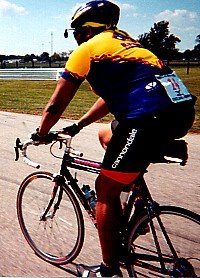An Epiphany...
An Immigrant Steeped In Meaning Of Thanksgiving
November 17, 2006
by Bessy Reyna
Thanksgiving kept coming to mind as I viewed the artwork now on display
at the Aldrich Museum for Contemporary Art in Ridgefield. The main
exhibition, the work of 10 artists both Indian and non-Indian, is called "No
Reservations: Native American History and Culture in Contemporary Art."
I was struck by the intensity of the work on view at each gallery, and the political content depicting the effect of the European conquest of Native Americans then and now. Living in Connecticut with the Mohegan Sun and Foxwoods casinos gives one a skewed view of contemporary American Indian life. This exhibition brings many other realities into sharp focus.
Since 1975, when he was sentenced to life in prison for allegedly killing of two FBI agents, Native American activist Leonard Peltier has been a beacon in the struggles of Native American people. His guilt or innocence is being debated to this day. At the Aldrich, artist Rigo 23 has recreated Peltier's tiny prison cell. Inside there is some of Peltier's original art work and, in glass boxes and on the floor, there are copies of his appeals, letters and other documents. The steps leading to the Peltier exhibit are
marked with each year that he has been imprisoned.
From a shoot-out between larger-than-life fiberglass cowboy and Indians, to the revisionist Hudson River School paintings of Peter Edlund, this show transforms the ordinary, the familiar and the beautiful providing new historical and cultural insights.
The symbolism of Marie Watt's "Dwelling" and learning of the Ridgefield community's involvement in this project represented the spirit of Thanksgiving for me. More than 1,000 blankets staked from floor to ceiling form a colorful and striking monolith. About 160 of these were donated by residents of Fairfield County and tagged with the story of how they were acquired or used by each family, in some cases for generations. Another
900 gray blankets were purchased by other donors. Dozens of people in the area spent hours sewing bindings around their edges. When the show ends in February, these blankets will be donated to local homeless shelters and families in need.
Simple blankets, traditionally used by Native Americans for trading or shelter and shamefully used by British forces to infect Native Americans with smallpox in 1763, now represent the commitment of a community working together to create something of beauty, to make connections between one another and to help others in need.
As I read the stories and learned that the people of Ridgefield had gotten together to make this a community project, I thought I was experiencing a "modern-day" Thanksgiving.
Each year as this holiday approaches, I think about how connected it is to my experience as an immigrant in this country.
As an undergrad at Mount Holyoke College, I was invited to join my friends' families, the Drinkos in Cleveland and the Pryors in Philadelphia. As a grad student at UConn in Storrs, I joined many families in celebrating in Connecticut. When I became part of my partner Susan's family, we spent hours on the road, regardless of the ice or snow, driving to Massachusetts. There, the whole family would recount anecdotes of their lives. I watched the nieces and nephews grow from little kids to suddenly sitting with their own children on their laps.
As I was leaving the Aldrich museum, I walked into an exhibition of photos by Paul Fusco. His photographs were taken at funerals of servicemen and women who died in Iraq including Army specialist Tyanna Avery-Felder of Bridgeport.
For the families of the men and women serving in Iraq and Afghanistan, each day they don't get horrible news about their loved ones must be a day of Thanksgiving.
Some of us are so used to the freedom and comforts we have that we don't even realize how much, and to how many, we have to be thankful.
I will think about that again this year. I hope we all do.
Bessy Reyna Freelance Writer/Hartford Courant


0 Comments:
Post a Comment
<< Home